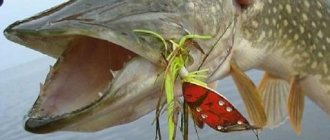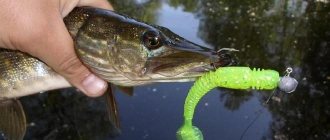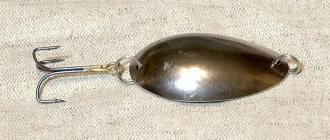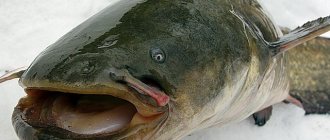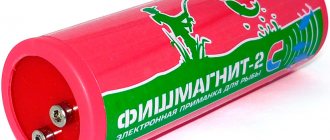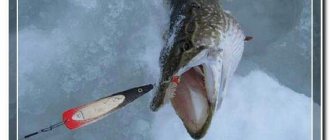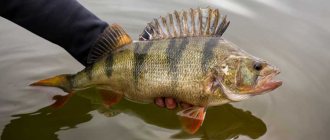What is the Kastmaster spinner
Castmaster spinner is a fishing bait that is one of the varieties of oscillating spinner, which is used both for spinning fishing and for vertical fishing.
Its classic version is made of a metal rod made of a special alloy, cut at an angle of 17 and 23 degrees and equipped with a winding ring to which a treble hook is attached. The outside of the spoon is coated with galvanic protection, and the hooks of the tees are coated with anti-corrosion protection. It can have a wide variety of colors and be equipped with additional elements.
Photo: Spinner Kastmaster original
The original version of this bait is produced by the American company Acme Tackle. It was founded by Henry Lavallee, who, together with his brother, was engaged in polishing and galvanizing jewelry. Henry invented the Kastmaster spinner by modifying one of the wobblers, the rights to manufacture and sell which he bought from the Eda fishing company.
Dimensions, weight
The length of the bait depends on its mass. Classic weight options in grams are: 7 (4.5 cm), 14, 21 (6.2 cm), 28 and 35. They also produce small models 2.5 (3.2 cm) and 3.5 g, as well as heavier spoons up to 56 g (2 oz). Weight distribution and dimensions may vary from manufacturer to manufacturer.
Playing in the water
The castmaster has a special geometric shape, a calculated center of gravity and a special material. Thanks to this, his game resembles a wounded fry who gradually falls to the bottom. This spinner has an average frequency and amplitude of oscillations.
For what kind of fish?
Catching asp with castmaster
Kastmaster oscillating spoons are used primarily when catching asp on a spinning rod, but are also suitable for fishing other predatory fish. So the catch can often include: perch, pike, chub, pike perch.
Almost all types of medium and large fish bite on this spoon of different weights with different types of bait movement. So, what is caught:
- Asp – bait weight up to 56 grams, fast uniform or wavy retrieve;
- Perch – up to 14 degrees, slow, uniform retrieve;
- Pike-perch, catfish, pike - classic jig step-by-step;
- Salmonids – trout, grayling, etc.
Fishing technique
The castmaster technique deserves special attention, since the overall success of spinning fishing largely depends on it. The type of wiring is directly related to the object being fished. When fishing for asp, fast, continuous retrieval works best. After splashdown, the bait is allowed to sink to the desired horizon, after which they begin to quickly rotate the reel handle. During the fight, the reel handles begin to be turned immediately after the spinner splashes down. At the same time, casting a castmaster is best done focusing on a specific splash of fish. As soon as the asp shows itself at a specific point, you should immediately throw the bait there and start quickly reeling it in. The asp will probably mistake the bait for a disoriented small fish.
We recommend reading: Selecting a nod for a winter fishing rod
To catch asp, you should generally choose a reel with a high gear ratio. It makes it easy to move the bait at maximum speed. In addition, you can alternate fast, uniform wiring with short pauses. Short-term freezing of the bait and sinking to the bottom will certainly interest the predator. The acceleration of the bait after a pause looks especially impressive. Here the hunter's instinct kicks in and the spinner will most likely be attacked.
Castmaster clearly deserves the attention of both novice fishermen and experienced spinning fishermen. The simplicity of this bait allows even beginners to easily master animation. The efficiency of the castmaster puts it on par with expensive spinners. So is it worth overpaying for other lures if you have a simple, reliable and proven castmaster? Let each reader answer this question for himself!
How to distinguish an original from a fake
Kastmaster Acme Tackle Co engraving does not guarantee that the lure is original. To distinguish a real Castmaster from a copy, you need to examine the features of its elements:
- the winding rings should be cut at an angle and inward (for copies at a right angle);
- the tees are covered with a matte layer of protection, and the hooks are sharp;
- the surface is well polished, the inscriptions are clearly applied, and the galvanic coating is of high quality;
- neat packaging.
About
The bait that catches everything, everywhere
Castmaster is a unique bait, a “universal soldier.” He catches fish on a high-speed straight line, he fishes with a stepped jig, in a plumb line from a boat, he also fishes from the ice in winter, he also fishes in the sea at great depths. It has excellent ballistic characteristics, is almost not subject to mechanical damage and corrosion, because it is made of galvanized metal.
If I were asked to choose one single bait with which to go fishing, I would not take an expensive wobbler, spinner or jig bait, but would choose a castmaster from the American company Acme. Recently, it has become for me not only the best bait, but also a kind of “litmus test”.
My list of “victims” of the castmaster also includes lovers of great depths: pike perch and bersh, and pike, which lives everywhere, and of course perch, and asp with ide, and even completely non-predatory fish, such as roach, saberfish, bream, and silver bream. And recently, on the rolls near Astrakhan, catfish weighing up to 5-6 kg became victims of castmaster. All that remains is to catch your favorite chub with it, and the list will be completed...
One day we were fishing at the Uglich Reservoir. The fishing pattern was familiar - in an area of the reservoir known to us with a characteristic topography, where a school of “forage” fish had already been found, we moved in boats along the slope into the Volga channel, making control casts, and waited for the daytime release of the pike perch. The “fanged ones” appeared almost on schedule, but my baits attacked occasionally, without being detected, while at the same time my friend pulled out one pike perch after another. I patiently changed the color of the twister, reduced its size - again zero. The foam rubber did not bring success either. Another pike perch pulled out of the water by a friend made me swallow my fishing pride and ask what he was fishing for. It turned out to be a castmaster. I was a little confused: firstly, at that time I did not have a native castmaster in my arsenal, but tried to fish only with homemade ones from a “birdie”; secondly, I never believed in this piece of hardware; and thirdly, then I mistakenly believed that if you fish from the bottom with stepped wiring, then the fish does not care what object it attacks - plastic, foam rubber or metal. But that day the fish only bit on the castmaster. Here you will inevitably believe in its catchability and unique properties.
Where and when is castmaster used?
They fish with it in different conditions: at stakes or on rivers with strong currents, from the shore or from a boat, and also from ice in winter.
Open water fishing
The method of using the spoon differs depending on the season. This is due to the behavior of fish at different times of the year.
in spring
At the beginning of this season, the fish are on the bottom, so stepped fishing is suitable for castmaster fishing, when after the spoon falls to the bottom, make half to three scrolls and again allow the bait to fall down, and so on until the bite. In mid-May, the fish rise higher, so you can use the fishing method for the warm period.
In summer
At this time of year, the fish changes its location depending on the time of day: in the evening, when the heat subsides, it is more in the upper layers of the water, so long casts with wiring sliding along the surface are used. During the day, in the hot sun, it goes to depth, so the castmaster is allowed to sink to the bottom, using heavier models.
in autumn
During this season, fish are often caught from the bottom with bait from 28 grams. stepped or uniform wiring in the bottom or middle layer. The fish hunt a lot at this time, so they actively move and move through the water column.
Ice fishing in winter
This is a special type of fishing that uses vertical lures with a castmaster. At the beginning of the cold season, the probability of catching is greater in shallow water - from 2-4 meters, and later you need to drill holes where the depth can be from 6 meters and use heavier spoons. Larger castmasters are suitable for ice fishing because the “hunting” occurs mainly at great depths where there is a current. If the water is cloudy, light castmasters are chosen, and in clear water, dark models are used.
Castmaster wiring
Castmaster is basically used as a jig bait, the wiring of which is carried out by quickly winding the reel while the spinning rod itself is stationary. Although such wiring is very primitive, it can show good efficiency and become basic at the beginning of fishing using a castmaster.
Such a jig will allow you to get used to the new bait and the fishing features associated with it, and only later you should start experimenting with the speed and length of the retrieve, changing the weight of the bait, etc. As with any other type of fishing, in order to get a good feel for the movement of the castmaster underwater, you need constant practice, which in the end will definitely be rewarded with high skill and good catches.
Castmaster fishing, wiring technique
This type of tackle is suitable for different wiring, both for uniform classic and specific:
| 1. Twitching | After casting, waiting for the tackle to sink to the bottom, it is slightly swayed from side to side. If after a cloud of silt rises during the fall, a bite does not occur, you need to create the impression that a weak fish is trying to break away from the bottom. To do this, the line is slowly pulled up, tugging with the tip of the rod. Even a well-fed predator can trigger the instinct to attack an exhausted prey. If this does not work, you can pretend that the easy prey is leaving. To do this, either reel in the reel, then let the bait drop a little, or periodically toss the rod. |
| 2. Bottom jerk wiring | Heavy castmasters are used for it. After casting, the rod remains pointed at the fallen spoon. Then the spinning rod rises sharply and stays in a vertical position, then the bait jumps up to the length of the rod. After the spoon sinks to the bottom, the cycle repeats. |
| 3. Jig step wiring | After the bait falls to the bottom, the rod is left motionless, and it is lifted from the bottom by rotating the reel. After lowering the Castmaster to the bottom, the action is repeated. In this case, you can change the speed of raising the bait, the length of the retrieve or the duration of pauses. |
| 4. Fishing along a cliff while holding | This method is used when fishing on the current where there are drops and edges. You need to choose the weight of the castmaster so that it barely touches the bottom. The spoon is thrown to the bank opposite in a downward direction and a stepwise retrieve is performed obliquely against the current. The castmaster will begin his signature play if he moves slower than the current. To adjust the speed, you can put the reel in reverse and hold back the speed manually, or lift the line handle and hold the line between your fingers. |
About
Castmaster on the river
When fishing on the river, the castmaster can be used as a drift spinner. To do this, a bait of a certain weight is thrown under the other bank, after which various places in the river are fished. The bait, supported by the force of the water, will move in a smooth arc.
In areas where the influence of the current weakens, the castmaster will begin to sink and eventually “fish” this water column. It is in such sections of the river that various fish often stand, waiting for food that is washed there by the current. The weight of the castmaster is selected taking into account the depth of the reservoir, the speed of the current and the desired catch.
It is also worth gradually increasing the casting range of the castmaster in order to check the entire accessible large section of the river. To fish in places where bites have appeared or where a predator has already been caught, you can try using a lighter-weight castmaster or completely change the type of bait, using, for example, a good-quality wobbler.
Reviews from anglers
Most fishermen note that pike, perch, asp and sometimes pike perch bite well on the Kastmaster. It flies far when casting and is easy to play in the water.
In order to make the best use of the features of the spinner and not create obstacles to its movements, it is necessary to properly equip the castmaster.
It is not recommended to use a winding ring, swivel or carbine to attach it to the main line, otherwise the spoon will not play and will fall over on one side. For such a bait, it is better to use an unequipped tungsten leash, which is attached using the “loop to loop” method. On the other side, a swivel is also attached to connect to the main fishing line. The recommended leash length is 20-30 cm, then the equipment is strong and the Kastmaster plays without hindrance.
Features of castmasters for fishing
What is a castmaster? This is a type of spinner that looks like a beveled cylinder. Moreover, the area of the base of such a cylinder is always greater than the area of the side. Standard models weigh 7, 14, 21, 28 and 35 grams. A winding ring and a tee are attached to the bait. Most often, bright silver and slightly less often golden castmasters are used. Lures are also sold in different colors and with holographic stickers.
What are the main advantages of castmasters? Firstly, they are suitable for fishing in fresh and salt water. They are also attacked by almost all the predators in the river. This versatility of baits is understandable. In the water, this seemingly beautiful, but simple piece of metal very realistically imitates a small fish. It is enough to perform uniform wiring to understand how well the castmaster plays in the water.

Another advantage of castmasters is that they fly far. But this is no wonder, since the bait weighs a lot and in case of side, gusty and headwinds, it still accurately flies along the correct trajectory.
If when fishing with light spinners or wobblers it is not always possible to send the bait accurately and far in headwinds and side winds, then when fishing even with light castmasters, making accurate casts is not a particular problem. Here is another reason why it is easier for beginners to fish with castmasters.
As for the castmaster’s playing, the vibrations are of medium frequency and the movements are uniform, without acceleration. With accelerated reeling, the bait does not reach the upper layers of the water very easily, but quickly enough. Such properties of castmasters allow you to use all types of retrieves, reeling speeds and catch predators in different layers of water.
Castmasters attach woolen threads, silicone skirts, bright cambrics and other “decorations” to some models. These elements make the castmasters' game more diverse and attractive.
Popular manufacturers of Kastmaster spinners
Due to the enormous popularity of the Kastmaster spinner, today it is produced by many fishing companies. The ranking of the TOP 8 manufacturers by the number of Internet requests (places are randomly distributed) is as follows:
- Acme
- Condor
- S.W.D.
- Flagman
- Mifine
- GRFish
- Sharks
- Spinner Kastmaster from Aliexpress (Aliexpress)
Some fishermen prefer to make castmasters with their own hands, additionally making some adjustments and spot changes to the design. All this, in their opinion, increases the catchability of the bait.
About
Photo of castmaster
Note!
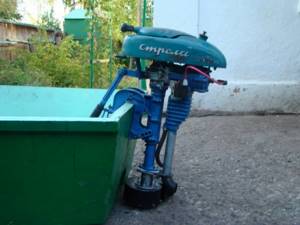
Do-it-yourself boat motor - tips for beginners, projects, drawings and step-by-step description of the construction of the main components and elements (video + 120 photos)
Feeder for winter fishing - secrets of use and techniques for feeding fish in winter (115 photos)
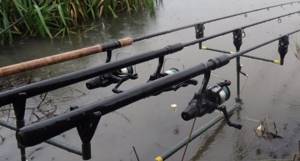
Bottom gear - the most effective types of equipment and features of casting techniques (95 photos and videos)
Read here Downrigger - tips on choosing and fishing for beginners. How to make a downrigger with your own hands (105 photos)
Help the project, share on social networks 

0
Features of pike fishing on Kastmaster
This bait is not recommended for use where there is a lot of snags and algae on the bottom, because the hooks often cling to what is in the water and there is a high risk of the gear breaking. Castmaster spinners for pike are good in the following places:
- deep holes,
- channel section,
- long ditches,
- edges, rifts and deep slopes.
Castmaster size for pike
When catching this predator, it is recommended to use several sizes of spoons, starting with a universal weight of 14 grams and a medium size. If the fish are not active, you can use a smaller bait, and if there is a chance of encountering a large pike, you will need a larger Kastmaster. You should not immediately use the smallest size spoon, as it may not interest large fish.
Wiring a castmaster for pike
Fishing with castmaster can be done in a variety of ways, such as:
- Uniform, unhurried - suitable for animation both in the headquarters and in a river with a strong current, both in the thickness of the reservoir and closer to its surface.
- Wave-shaped - used in the water column and in the coastal strip.
- Uneven is a method of provoking a sluggish predator to attack the bait, used in different conditions.
- Stepped – suitable for animation at depth, when hunting large individuals in any type of reservoir.
- Ryvkovaya, used mainly in the water column.
Why autumn is the best time to catch pike with castmaster
Before wintering, the predator accumulates nutrients, so it feeds especially actively. It is more mobile, so it can be found both in the water column and closer to the bottom. It is in this range that the castmaster works.
Video: Castmaster fishing for pike
Not exactly a practical master class, but the video gives a clear idea that pike can be caught perfectly with this bait.
The castmaster is a lure that different types of freshwater and sea predators cannot resist, especially when played skillfully. In our opinion, such a bait should be in the arsenal of any spinning rod and winter angler.
Views: 636
Similar articles:
- Spinner for pike. The best lures for catching pike Pike is one of the most popular fish for catching. This…
- The most catchy spinners for pike. Top 10 spinners Don't get carried away by the wide variety of spinners, just a few spinners are enough...
- Catching pike in winter with a spoon. Top 5 best winter lures for pike When cold bodies of water are finally covered with a layer of ice, for many avid…
- Pinwheels for pike. Top 10 most catchy Spinners like “Mepps” are one of the most effective baits...
Wiring methods
When fishing for pike or perch, move the bait evenly, sometimes pausing. In this case, the technique of guiding a castmaster is no different from the technique of wiring a conventional oscillating spoon. It is enough to alternate a triple turn of the reel handle with a second pause in order to achieve success. Everyone knows the love of pike perch for narrow, oscillating spoons! But the castmaster is just one of these lures. But pike perch usually stays at the bottom of the reservoir. Therefore, in the case of hunting for pike perch, they use the classic stepped retrieve, characteristic of jig fishing.
Frankly speaking, it’s easier to use a classic jig. After all, there will be significantly fewer hooks. Many fishermen go this route. But if you put a triple or single hook with protection against snags on your castmaster, you can outperform the jig in terms of effectiveness. After all, the vast majority of spinning anglers catch with soft silicone baits. Because of this, pike perch are extremely wary of such baits. But the castmaster most often does not arouse any suspicion in him. Moreover, a heavy spinner constantly raises turbidity when hitting the bottom. This quickly attracts predatory fish, which probably associate the spoon with a fry poking around in the mud.
Recommended reading: How to catch pike perch with live bait
Choosing a spinning rod for a castmaster
This is a very subtle point. Firstly, I’ll say right away that there should be several spinning rods, covering the entire line of baits with their tests. Because often only small-sized castmasters catch passive fish, while heavier ones do not. And for light bait you need a spinning rod with a certain test. For bait of the next weight, you also need your own spinning rod, and so on, depending on the depth of fishing and the speed of the current.
Let’s assume that the main topography of the reservoir where we are fishing is underwater mounds, ravines or vast plateaus next to the riverbed—feeding outlets for schools of pike-perch, bersh and perch, and the traditional “jig” weights that are used in these places are 10-14g. The upper limit of the rod test is a spinning rod 7.0-8.0 feet long with 12-14 grams of lures, used for fishing with a 14-gram castmaster, and 6-10 pounds of line.
If fishing is carried out at shallow depths or the perch is at half-water, use a bait weighing 7 g or less and an appropriate spinning rod. A fast action spinning rod with a thin flexible tip is best suited for a castmaster . Working in the upper range of the spinning rod allows you to better feel the play of the bait - most of the top of the blank is bent under load, and due to this, the separation of the bait from the bottom is smooth, and the phase of falling and “fluttering” in the water column turns out to be continuous, visually close to falling to the bottom stunned fish.
That is, when the forward thrust stops (during the falling phase of the bait), the tip of the spinning rod does not stop working, fully straightening in one second, but is constantly under load, which allows you to be in constant contact with the bait, and clearly works in time with the bait, tracking it work. After all, fish are often caught precisely during the falling phase, and the loaded tip of the spinning rod helps to reliably detect it. To put it simply, the tip of the spinning rod at this moment plays the role of a nod and a kind of hooker. That is why it is important to accurately select the weight of the bait for the depth - here, as with jig fishing, it is not possible to use heavy baits at small and medium depths - the castmaster must hover in the water column for as long as required in a given place, and its weight must be optimal (and often - minimal) for a specific bottom landscape.
In addition, very often, if not always, a passive perch needs the bait to have clear contact with the ground. The perch approaches the gliding castmaster, but does not dare to attack it. The “dying fish” lies motionless on the bottom, but then suddenly comes to life in a brazen manner and tries to escape. The perch is no longer able to withstand this behavior of the prey and attacks the bait. If a spinning angler uses too coarse tackle for fishing, then it will not be possible to “catch” the desired contact with the ground.
